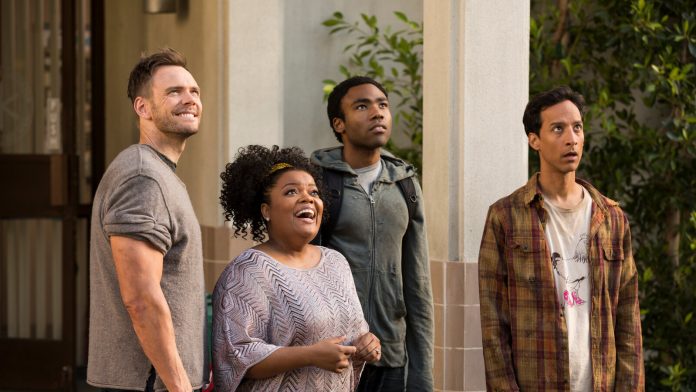This cult favorite comedy had a simple premise, but its mission was more complex: to deconstruct the modern sitcom.
In the early days of the pandemic, when everyone was bored at home, I took an extremely comprehensive online personality quiz designed to determine your similarity to more than 1,600 fictional characters from TV, literature and film. My closest counterpart, with a 96 percent match, was Jeff Winger, the charismatic lead character played by Joel McHale on NBC’s cult sitcom “Community.”
The question of whether someone should aspire to be like Jeff — a conceited, silver-tongued attorney forced to slum it at a third-rate community college after his law degree is revealed to be bogus — is a matter for me and my therapist. But I can’t say I was surprised by the comparison. I’ve watched “Community” more than other series, by a factor of about a hundred.
I watched its first five seasons during their original run on NBC, between 2009 and 2014, and I watched its sixth and final season the following year on the short-lived streaming service Yahoo! Screen. I still watch it all the time, in bed on my iPad, on long flights, on the sofa over meals. I watch it when I’m anxious or stressed out or need something to buoy my spirits. I watch it when I can’t think of what else to watch. I rewatched the whole thing from beginning to end at the start of the pandemic, and I recently started it all over again.
So of course a bit of Jeff’s trademark Winger charm bled through. Given all that exposure, some osmosis was inevitable.
“Community” is the ultimate postmodern sitcom. The premise is deceptively ordinary: Jeff, smitten with his fellow student Britta (Gillian Jacobs), hastily assembles a motley study group made up of outcasts in their Spanish class, then convinces her to sit in. He plans to cheat his way to a legitimate law diploma — the school’s drunken psychology professor, Duncan (John Oliver), owes him a favor — but when Duncan refuses to cooperate, Jeff realizes he’ll actually need the study group’s help. The crew bonds and flourishes, with Jeff as their de facto leader, and as the series progresses, we follow their journey from classmates to friends.
That’s the elevator pitch. The elevator pitch is a misdirect.
Dan Harmon, the creator, used “Community” to deconstruct the mainstream sitcom. Looking back at the series now, a decade after it debuted, it’s not surprising that NBC had creative conflicts with Harmon and his writing staff. (Harmon was fired by the network after the third season, then brought back for the fifth after the fourth faced vociferous criticism.)
“Community” is so dark, difficult and defiantly idiosyncratic at times that it doesn’t merely seem unconventional — it seems actively hostile to casual audiences, with ratings to match. But those who did like the show tended to do so passionately; fans championed “Community” tirelessly as NBC (repeatedly) threatened to cancel it.
In retrospect, it seems like a miracle that “Community” made it to air at all. There was nothing else on television quite like its blend of heart and idiosyncratic cultural literacy. And while the show ended years ago, it continues to shape pop culture. The regular series directors Anthony and Joe Russo brought some of the same playful wit to the blockbusters they went on to oversee, including multiple “Avengers” movies. Several of the stars have also gone on to successful careers, especially Alison Brie, Donald Glover and Ken Jeong. And Harmon finally has a hit: The animated sci-fi comedy “Rick and Morty,” which he created with Justin Roiland for Adult Swim, is now in its fifth season and is widely beloved.
Time has vindicated Harmon’s tenacity in realizing his creative vision, whatever the cost in alienating bewildered viewers. The proof is in how inexhaustibly re-watchable “Community” remains. Here are three reasons its greatness has endured.
The Homages
Not spoofs: “I prefer the term ‘homage,’” as the film buff Abed (Danny Pudi) tells Jeff at the end of an episode modeled on the talky, urbane 1981 drama “My Dinner With Andre.” One of the show’s boldest conceits was its tendency to stage entire episodes as exercises in a particular style or genre. Sometimes these modes were broad and recognizable, as in the Season 2 finale, based around a paintball fight and shot like one of Sergio Leone’s spaghetti westerns. More often — as in the case of the “My Dinner With Andre” parody — the series would riff on something more obscure, particularly by the standards of network television.
“Documentary Filmmaking: Redux,” from Season 3, in which Dean Pelton (Jim Rash) attempts to direct a commercial for Greendale College and is driven to madness in pursuit of perfection, is based on “Hearts of Darkness,” the behind-the-scenes documentary about Francis Ford Coppola’s difficulties making “Apocalypse Now.” It makes you wonder: How many people have seen “Hearts of Darkness,” and how many of them would have been tuning in to an NBC sitcom on a Thursday night? But you have to admire the commitment to the bit.
The Ensemble
The inside-joke quality of this esoteric humor, including the arcane homages, works largely because of the dedication of the cast, who are all-in on Harmon’s brand of weirdo comedy. The core study group has spectacular chemistry and gamely handles every odd detour, thanks to a cast that also includes Brie as a bookworm and reformed pill-popper, Annie; Glover as the jock with the heart of a nerd, Troy; Yvette Nicole Brown as the devout single mother, Shirley; and Chevy Chase as the prickly geezer, Pierce. Harmon often wrote them into unexpected combinations and pairings, and one of the show’s pleasures is watching them work as an interlocking comedy unit.
The supporting actors were just as likely to steal a scene. Jeong was so good as the less-than-qualified Spanish professor Ben Chang in the first season that his role was expanded greatly as the series went on. Rash, likewise, moved from recurring role to series regular, and in many ways feels like the heart of the show.
And like “The Simpsons,” “Community” has a knack for introducing zany characters as punch lines only to flesh them out later: Dino Stamatopoulos, one of the show’s producers, became a fan favorite as Star Burns (so named for his star-shaped sideburns). And one of the most memorable characters is Luke Youngblood’s Magnitude, a “one-man party,” as he is introduced, whose dialogue is limited to the exclamation “pop pop!”
The Ambition
Throughout its six-season run, “Community” pulled off things most shows would never dream of attempting. (That they pulled them off under the eyes of skeptical NBC executives is even more impressive.) This is a network sitcom whose second-season clip show is made up of entirely original material — a parody of a format typically used to save time and money that ended up being even more elaborate and time-consuming to make than a regular episode. Harmon said in the episode’s DVD commentary that he even spent $30,000 of his own money to secure the rights to Sara Bareilles’s “Gravity” because he badly wanted to use it.
Harmon and his collaborators never phoned it in on “Community.” There’s a “Rudolph the Red-Nosed Reindeer”-inspired Christmas special done in stop-motion animation. There’s an episode set inside an 8-bit video game, and another animated to look like the old “G.I. Joe.” Even the show’s one obvious “bottle episode” — another typically cost-saving format, in which minimal action takes place entirely within one location — is a complex meta-story that is explicitly about bottle episodes (“Cooperative Calligraphy,” one of the best installments of the series).
My personal favorite, “Remedial Chaos Theory,” has the same incident unfolding simultaneously in seven different alternate universes. What other show could have done that? What other show would have tried?





























